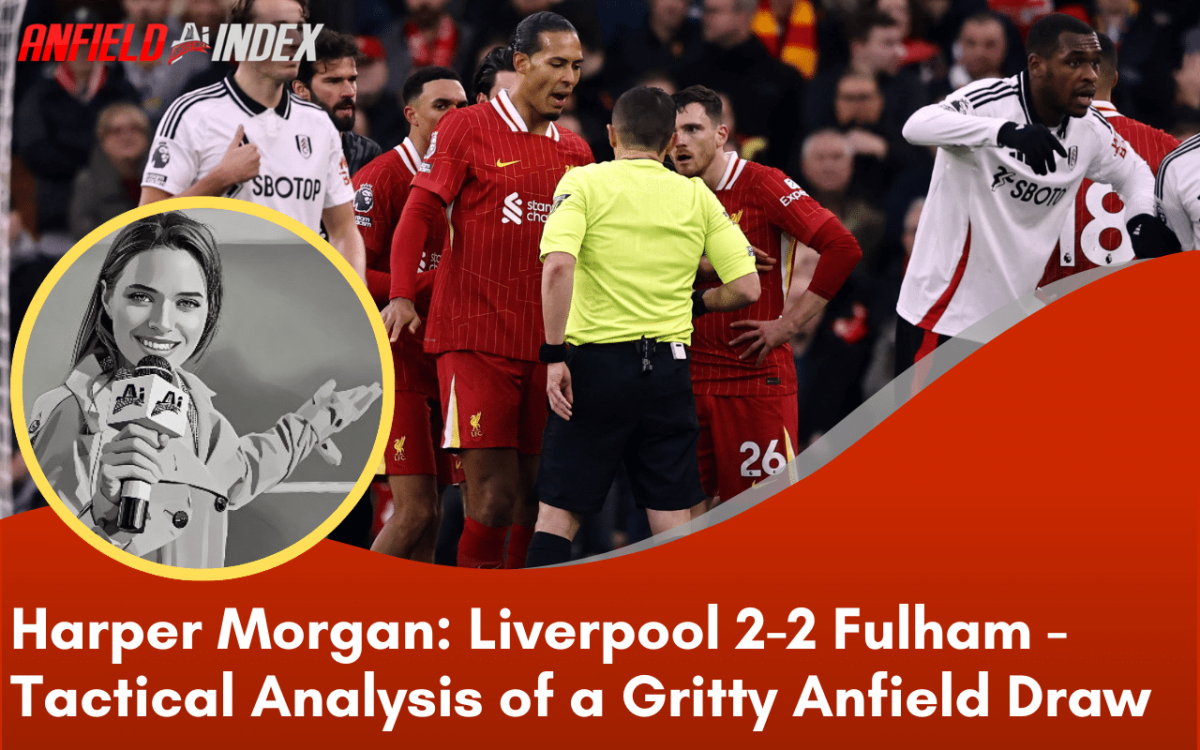
It was one of those dreaded 3 p.m. blackout matches in the UK, where resourceful fans find their way to NBC’s Peacock stream via a reliable VPN. As Liverpool fell behind and Andy Robertson saw red after 17 minutes, I couldn’t help but wonder if this was a game worth all the effort. But it turned out to be an engrossing and chaotic match that reflected the courage and quality of this Liverpool team.
Play with 10 men for over 70 minutes
Liverpool’s 2-2 draw with Fulham at Anfield on Saturday afternoon was testament to their resilience. Reduced to 10 men for more than 70 minutes after Andy Robertson was sent off, the team showed remarkable spirit to snatch the point. Given the circumstances, that’s less of a two-point loss and more of a hard-earned gain.


In a Premier League title race, every non-win stings. But analytically, Liverpool’s recovery to draw after being behind and playing a man down was impressive. As a reminder, starting with 10 men is worth around 0.8 goals for the opposition. Liverpool not only absorbed this disadvantage but also created a notable amount of xG (expected goals). The pursuit of scoring may have inflated the numbers, but their offensive persistence underlined the quality of the performance.


Before the red card, Liverpool pressed with an adjustment: Dominik Szoboszlai and Curtis Jones pushed higher to help the attackers. Yet Robertson’s poor contact, which led to the foul and subsequent red card, was a moment of dismay. Unfortunately, these errors are becoming common; he conceded costly penalties against Real Madrid and Southampton last season.


Robertson’s struggles and the left-back conundrum
Liverpool’s defensive structure had to adapt quickly after Robertson’s departure. Arne Slot’s second-half adjustments were key, particularly against a Fulham side who failed to capitalize on their numerical advantage. Marco Silva’s side were strangely passive, offering few sustained attacks and instead content to protect their narrow lead.


Trent Alexander-Arnold, often Liverpool’s creative outlet, was unusually inconsistent with his passing. He completed 80% of his passes (53/66), but only 5 of his 13 long passes found their mark, and his success in crossing was non-existent. Defensively, he lost six out of eight duels, figures which highlight his difficulties of the day.


Yet Alexander-Arnold still had moments of brilliance. A remarkable pass rounded five Fulham players and launched Joe Gomez into a transition attack. Moments like these remind us why Trent remains such a vital figure, even when his overall play falters.
Tactical adjustments and tenacity in midfield
The midfielders mobilized remarkably to compensate for Liverpool’s numerical disadvantage. Ryan Gravenberch and Szoboszlai, in particular, were immense out of possession, while Harvey Elliott provided a spark in attack. Elliott’s performance was significant: he led the team in expected threat (xT) on open play passes – an even more remarkable feat considering his return from injury.


Liverpool’s xT heatmap revealed a reliance on creating from the right-sided half-spaces – a pattern shaped by necessity with 10 men. Despite their numerical disadvantage, Liverpool got around Fulham’s press well, with their midfield positioning helping to facilitate the build-up.


Gravenberch’s transformation this season has been extraordinary. After Robertson’s dismissal, he slotted in at right centre-back before moving back into midfield when Jarell Quansah came on. His versatility and hard work rate stood out. Alongside Szoboszlai and Jones, the Liverpool midfielder has the makings of a dominant force in Europe for years to come, especially with the return of Alexis Mac Allister on the horizon.
Jota’s comeback and Szoboszlai’s growing influence
Diogo Jota, back from injury, was as sharp as ever – one of those rare players who seems to emerge from rehab fully match-ready. He took two shots from the danger zone and found the net with just one, a clinical demonstration of his value to this team.


If he can stay fit, Jota’s knack for scoring timely goals will prove crucial in the months to come.
Dominik Szoboszlai, meanwhile, continues to gain influence. Leading the team in passes into the opposition box, his improved performances on the ball mark a resurgence in form. The Hungarian midfielder is gradually finding his rhythm, and his creative spark will be vital in breaking down defenses in tight matches.


Despite the circumstances, Liverpool managed to generate a significant offensive threat. The combined courage, tactical discipline and flashes of quality on display here bode well for the challenges ahead.


Overview
A home draw against Fulham can feel like losing two points, especially given Liverpool’s ambitions. But in reality, it’s a point won through sheer determination. The effort and resilience displayed were clear indicators of a team capable of going the distance.
It wasn’t perfect: Alexander-Arnold’s struggles, Robertson’s error and Fulham’s failure to kill off the game all created a difficult situation. And for those of us who rely on transatlantic feeds, as Liverpool struggled to a 2-2 result, I began to wonder if a VPN-induced headache was worth it .
Ultimately, though, it’s a reminder of Liverpool’s enduring struggle and growing depth. The road ahead is long, but it is paved with justified hopes.
